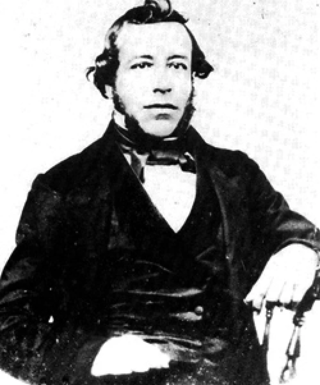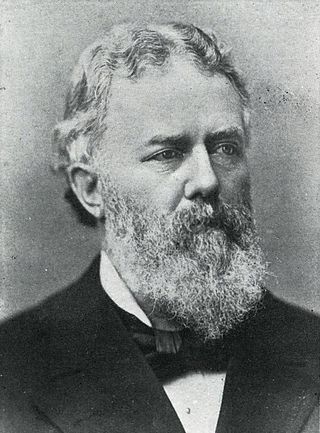The Los Angeles County Board of Supervisors is the legislative body of Los Angeles County, California.
The State of California was founded in 1850. On February 18, 1850, the County of Los Angeles was established as one of the 27 original counties, several months before California was admitted to the Union. The Los Angeles County Board of Supervisors was created in 1852. The Court of Sessions was used under Mexican custom until 1852. The court was composed of a County Judge and two County Associate Justices. Julian A. Chavez served in the Court of Sessions as a "Judge of Waters" and later as a "Judge of the Plains" prior to the formation of the Board of Supervisors.
| Year | Representation |
|---|---|
| Before 1850 | Court of Sessions. Before board creation. |
| 1850 | Court of Sessions |
| 1851 | Court of Sessions |
The Los Angeles County Board of Supervisors was created in 1852. Terms of office through the first decade were for one year. A piece of the county's territory was given towards the creation of San Bernardino County in 1853. [Note: Names in black have an article under that name, but not the person concerned in this table].
Terms of office changed to two years. A piece of the county's territory was given towards the creation of Kern County in 1866.
| Year | 1st District | 2nd District | 3rd District | 4th District | 5th District |
|---|---|---|---|---|---|
| 1862 | Julius Morris | Benjamin D. Wilson | Fielding W. Gibson | Cristobal Aguilar | Vicente Lugo |
| 1864 | Asa Ellis | Benjamin D. Wilson | Cristobal Aguilar | Julius Morris | Philip Sichel/ Maurice Kremer |
| 1866 | John G. Downey | Maurice Kremer | Edmund H. Boyd | Felix Signoret | Eduardo Poyoreno |
| 1868 | Wallace Woodworth | James B. Winston | Robert Henry Mayes | A. Langenberger/ Hugh Forsman | Enrique Avila |
| 1870 | Hugh Forsman | G.D. Cankton | E. Sanford | Enrique Avila | R. Yorba |
Los Angeles County is divided into four districts with two persons on behalf of the First District. [Note: Names in black have an article under that name, but not the person concerned in this table].
| Year | 1st District (Person 1) | 1st District (Person 2) | 2nd District | 3rd District | 4th District |
|---|---|---|---|---|---|
| 1872 | Francisco Machado | Samuel Bradford Caswell | Hugh Forsman | Francisco Palomares | Alfred Louis Bush |
| 1874 | Francisco Machado | John M. Griffith/ Gabriel Allen | George Hinds | Francisco Palomares | Edward Evey |
| 1876 | John D. Young | Gabriel Allen/ Charles Prager | George Hinds/ John J. Morton | J.C. Hannon | Edward Evey/ W.H. Spurgeon |
| 1878 | John D. Young/ A.H. Rogers | Charles Prager | John J. Morton | J.C. Hannon | W.H. Spurgeon/ James D. Ott |
| 1880 | A.H. Rogers | Charles Prager | W.F. Cooper | J.C. Hannon | James D. Ott/ Richard Egan |
| 1882 | A.H. Rogers | Charles Prager | W.F. Cooper | J.C. Hannon | Richard Egan |
Los Angeles County is divided into seven districts.
| Year | 1st District | 2nd District | 3rd District | 4th District | 5th District | 6th District | 7th District |
|---|---|---|---|---|---|---|---|
| 1883 | L.G. Giroux | Charles Prager | William M. Osborn | Dave V. Waldron | S. Levy | Dan Reichard | J.H. Moesser |
Los Angeles County is divided into five districts. Districts 1 & 3 remain at a term of two years for one period, and then four years thereafter. Districts 2, 4, & 5 now have a term of four years. All districts became four-year terms in a phased in process by 1887. This allows for staggered elections every two years, which is still in effect. A piece of the county's territory was given towards the creation of Orange County in 1889. Although all local government positions in California are officially nonpartisan, virtually all board members are members of a political party and, if known, that information is included with the article.
The government of California is the governmental structure of the U.S. state of California as established by the California Constitution. California uses the separation of powers system to structure its government. It is composed of three branches: the executive, consisting of the governor of California and the other constitutionally elected and appointed officers and offices; the legislative, consisting of the California State Legislature, which includes the Assembly and the Senate; and the judicial, consisting of the Supreme Court of California and lower courts. There is also local government, consisting of counties, cities, special districts, and school districts, as well as government entities and offices that operate independently on a constitutional, statutory, or common law basis. The state also allows direct participation of the electorate by initiative, referendum, recall and ratification.

The United States district courts are the trial courts of the U.S. federal judiciary. There is one district court for each federal judicial district. Each district covers one U.S. state or a portion of a state. There is at least one federal courthouse in each district, and many districts have more than one. District court decisions are appealed to the U.S. court of appeals for the circuit in which they reside, except for certain specialized cases that are appealed to the U.S. Court of Appeals for the Federal Circuit or directly to the U.S. Supreme Court.

The Los Angeles County Board of Supervisors (LACBOS) is the five-member governing body of Los Angeles County, California, United States.

Manuel Requena (1802–1876) was a Yucatán-born Californio politician who served multiple terms as Alcalde of Los Angeles. Requena became active in Los Angeles politics in the 1830s, during the Mexican era, and continued serving after the American Conquest of California until his death in the 1850s.

Stephen Clark Foster was a politician, the first American mayor of Los Angeles under United States military rule. Foster served in the state constitutional convention, and was elected to the State Senate. He was elected as mayor of Los Angeles in 1856, and later elected for four terms to the Los Angeles County Board of Supervisors.

Stephen Lawrence Cooley is an American politician and prosecutor. He was the Los Angeles County District Attorney from 2000 to 2012. Cooley was re-elected in 2004 and again in 2008.

The Constitution of the State of Michigan is the governing document of the U.S. state of Michigan. It describes the structure and function of the state's government.

Agustín Olvera (1820–1876) was a Californio judge, ranchero, and politician in 19th century Los Angeles. Olvera served as the first elected Los Angeles County Judge and also served on the Los Angeles Common Council. He is the namesake of Olvera Street by the Plaza de Los Ángeles.

The government of the U.S. State of Oklahoma, established by the Oklahoma Constitution, is a republican democracy modeled after the federal government of the United States. The state government has three branches: the executive, legislative, and judicial. Through a system of separation of powers or "checks and balances," each of these branches has some authority to act on its own, some authority to regulate the other two branches, and has some of its own authority, in turn, regulated by the other branches.

Matthew Paul Deady was a politician and jurist in the Oregon Territory and the state of Oregon of the United States. He served on the Oregon Supreme Court from 1853 to 1859, at which time he was appointed to the newly created federal court of the state. He served as a United States district judge of the United States District Court for the District of Oregon in Portland, as the sole Judge until his death in 1893. While on the court he presided over the trial that led to the United States Supreme Court decision of Pennoyer v. Neff concerning personal jurisdiction.

Julián Antonio Chávez was a Hispano-Californio ranchero, landowner and public official in 19th-century Los Angeles, California. Chávez served multiple terms on the Los Angeles Common Council and the Los Angeles County Board of Supervisors. He is the namesake of Chavez Ravine.

David W. Alexander was an early California politician and pioneer in Los Angeles County, California. He was on the Board of Supervisors in 1853 and 1854, and in 1855 he was elected the third sheriff for the county.
The 2nd Arizona Territorial Legislative Assembly was a session of the Arizona Territorial Legislature which began on December 6, 1865, in Prescott, Arizona, and ran for 24 days. The sessions chief accomplishments were creation of Pah-Ute County and establishing Arizona as a community property jurisdiction.

The Government of Los Angeles County is defined and authorized under the California Constitution, California law, and the Charter of the County of Los Angeles. Much of the Government of California is in practice the responsibility of county governments, such as the Government of Los Angeles County. The County government provides countywide services such as elections and voter registration, law enforcement, jails, vital records, property records, tax collection, public health, health care, and social services. In addition the County serves as the local government for all unincorporated areas.

The government of the City of Los Angeles operates as a charter city under the charter of the City of Los Angeles. The elected government is composed of the Los Angeles City Council with 15 city council districts and the mayor of Los Angeles, which operate under a mayor–council government, as well as several other elective offices. Under the California Constitution, all judicial, school, county, and city offices, including those of chartered cities, are nonpartisan. The current mayor is Karen Bass, the current city attorney is Hydee Feldstein Soto and the current city controller is Kenneth Mejia.
The Judiciary of California or the Judicial Branch of California is defined under the California Constitution as holding the judicial power of the state of California which is vested in the Supreme Court, the Courts of Appeal and the Superior Courts. The judiciary has a hierarchical structure with the California Supreme Court at the top, California Courts of Appeal as the primary appellate courts, and the California Superior Courts as the primary trial courts.

The 2020 Los Angeles County elections were held on November 3, 2020, in Los Angeles County, California, with nonpartisan blanket primary elections for certain offices being held on March 3. Three of the five seats of the Board of Supervisors were up for election, as well as one of the countywide elected officials, the District Attorney. In addition, elections were held for various community college districts and water districts, as well as the Superior Court.

The 2022 Los Angeles County elections were held on November 8, 2022, in Los Angeles County, California, with nonpartisan blanket primary elections for certain offices being held on June 7. Two of the five seats of the Board of Supervisors were up for election, as well as two of the countywide elected officials, the Sheriff and the Assessor. In addition, elections were held for the Superior Court, along with two ballot measures.

The Superior Court of California, County of San Luis Obispo, also known as the San Luis Obispo County Superior Court or San Luis Obispo Superior Court, is the branch of the California superior court with jurisdiction over San Luis Obispo County.